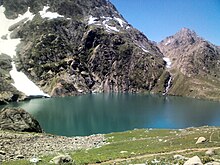Gadsar Lake
| Gadsar Lake | |
|---|---|
| Lake of Fishes | |
 | |
| Location | Ganderbal district, |
| Coordinates | 34°25′18″N 75°03′26″E / 34.421669°N 75.057274°E |
| Type | oligotrophic lake |
| Primary inflows | Melting of snow |
| Primary outflows | A stream tributary of Neelum River |
| Basin countries | |
| Max. length | 0.85 kilometres (0.53 mi) |
| Max. width | 0.76 kilometres (0.47 mi) |
| Surface area | 0.7421 km2 (0.2865 sq mi) |
| Surface elevation | 3,600 metres (11,800 ft) |
| Frozen | December to April |
The Gadsar Lake,[1] also called Yemsar, is an alpine high altitude oligotrophic lake[2] in the Ganderbal district[3] of Kashmir Division in Jammu and Kashmir, India. It has an elevation of 3,600 metres (11,800 ft), a maximum length of 0.85 km and maximum width of 0.76 km.
Etymology, geography[edit]

Gadsar in Kashmiri means the lake of fishes, a natural habitat of trout and other types of fishes[4] among of which is the brown trout.[5] Yemsar means Lake of Yama.[6] The lake freezes in the month of November to April and is mostly covered by snow during these months, the floating ice bergs are seen even in summer. It is surrounded by alpine meadows full of various kinds of wild alpine flowers, therefore the lake is also called as the valley of flowers.[7] The lake is mainly fed by melting of glaciers. The Gadsar Lake outflows through a stream flows north westwards and joins Kishanganga River at Tulail.
Access[edit]
The Gadsar Lake is situated 108 kilometres northeast from Srinagar city. From Naranag a 28 km alpine track leads to the lake. Another track of 41 km northwest from Shitkadi Sonamarg via Vishansar Lake and Krishansar Lake leads to the Gadsar Lake crossing two mountain passes of Nichnai and Gadsar of more than 4100 meters above sea level.[8] The best time to visit is from the month of June to September.
Gadsar, the lake of death[edit]
The Gadsar Lake is also called Yemsar which means the lake of Yama and is also referred to as the lake of death.[9] A myth still unresolved. Shepherds grazing their flocks in the outskirts of Gadsar lake during summers believe that, there lives a Lake Monster, a freshwater Octopus which drags the creatures from shores by its tentacles into the water. There is an uncertainty in the minds of visitors, a kind of threat which prevents them going near the shores. The shepherds also chose otherwise grazing their flocks at the shores of the lake. The fishes are being caught outside the lake in a stream from which it flows out.
References[edit]
- ^ Charles Metcalfe MacGregor; Charles Ellison Bates (1995). Central Asia: section 1. A gazetteer of Kashmír. Barbican Publishing Company, 1995. pp. 188, 496–. ISBN 978-1-900056-85-4. Retrieved 31 July 2012.
- ^ Raina, HS; KK Vass (May–June 2006). "Some biological features of a freshwater fairy shrimp, Branchinecta schantzi, Mackin, 1952 in the Northwestern Himalayas, India" (PDF). J. Indian Inst. Sci. 86: 287–291. Retrieved 21 February 2012.[permanent dead link]
- ^ "Gangabal in Ganderbal". kashmirparadise.com. Archived from the original on 25 April 2012. Retrieved 19 April 2012.
- ^ "Fishes and Fisheries in high altitude lakes, Vishansar, Gadsar, Gangabal, Krishansar". Fao.org. Retrieved 19 April 2012.
- ^ Petr, T., ed. (1999). Fish and fisheries at higher altitudes: Asia. Rome: FAO. p. 72. ISBN 92-5-104309-4.
- ^ Excelsior, Daily (17 August 2012). "Sacred Shrines of Haramukh". Retrieved 15 May 2021.
- ^ "Gadsar the valley of flowers". aazadkashmir.com. Retrieved 19 April 2012.[permanent dead link]
- ^ "Go to Kashmir". go2kashmir.com. Retrieved 19 April 2012.
- ^ Excelsior, Daily (17 August 2012). "Sacred Shrines of Haramukh". Retrieved 15 May 2021.



